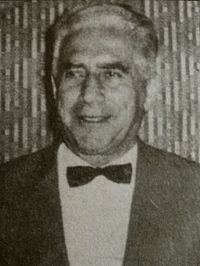Cause of death Heart attack Role Architect | Name Nasreddin Murat-Khan Ethnicity Turkic | |
 | ||
Native name نصر الدین مراد خان (Ottoman Turkish)Nasreddin Murat-han (Turkish)Nasreddin Murathanov (Russian)نصر الدین مرات خان (Urdu) Resting place New Elahi Park, Misri Shah Cemetery, Lahore31°35′9″N 74°19′58″E / 31.58583°N 74.33278°E / 31.58583; 74.33278 Nationality Russian (1907–1950)Pakistani (1950–1970) Notable work Minar-e-PakistanGaddafi Stadium Died October 15, 1970, Lahore, Pakistan Structures | ||
Nasreddin Murat-Khan (1904–1970) was a Russian-born Pakistani architect and civil engineer. He is remembered most for designing the national monument, the Minar-i Pakistan. He was also the architect of the Gadaffi Stadium in Lahore and several other notable buildings and structures.
Contents
- Early life
- Exile
- Pakistan
- Death
- Professional career
- Minar i Pakistan
- Awards
- Views and legacy
- Gallery
- References
Early life
Murat-Khan was born in 1904 to a Turkic Muslim family, in the North Caucasus region of Dagestan located in the Russian Empire (later part of the Soviet Union, and now the Russian Federation). In 1930, he obtained his degree of civil engineering from the Institute of Architects, Town Planners and Civil Engineers at Leningrad State University (now the Saint-Petersburg State University). Later, he also obtained degrees of architecture and town planning from the same university.
Exile
Murat-Khan was keen to free the Muslim Caucasus region from Soviet control. As a result, he had to flee from Dagestan—for the fear of his life—to Germany where he landed sometime in 1944. He stayed as a refugee in one of the camps established by the UNRRA in Berlin, later moving to Mittenwald where he married Hamida Akmut, a Turkish refugee, in 1946.
Pakistan
After the six-year-long exile in West Germany, Murat-Khan migrated with his family to Pakistan, in 1950.
Death
Murat-Khan died of a heart attack on 15 October 1970.
Professional career
In 1930, Nasreddin held a variety of posts in Dagestan and in Leningrad. He was arrested during the "Engineers' Purges" undertaken by Stalin, but was re-instated in February 1940 as Chief Engineer and Chief Architect of the Pyatigorsk branch of the North Caucasian Project Trust. He later served as Chief Engineer and Director of the North Caucasian Project Trust in Woroschilowsk, Ukraine, till August 1942. Murat-Khan planned and designed many buildings of the Soviet Union, which includes a Lenin Memorial. In 1950, after his migration to Pakistan, he was hired as Executive Engineer for PWD at Wah Ordinance Factory. He then was reassigned in 1951 as Special Architect, B&R Deptt., PWD, where he designed the buildings of the Nishtar Hospital and the Nishtar Medical College. In addition, he also prepared the designs of the Mansehra Mental Hospital, the Sahala Police Training College, the Sinclair Hall in Forman Christian College, the Gaddafi Stadium in Lahore (completed in 1959 and initially called the Lahore Stadium) and the Textile College, Faisalabad among many other buildings, townships, residences and other structures.
Minar-i Pakistan
Murat-Khan's most notable and memorable work is his design of the Minar-i Pakistan monument, located at Minto Park (now Iqbal Park) in the walled city of Lahore. The foundation stone of Minar-i Pakistan was laid at Minto Park on 23 March 1960. In 1963, President Ayub Khan reportedly summoned Murat-Khan to his office and took out a fountain pen from his pocket, placed it upright on his desk and instructed Murat-Khan to "build me a monument like this."
Murat-Khan was very keen on the supervision of the construction and the design. He frequently visited the site to inspect building material, construction quality. He did not take his prescribed fee of Rs. 250,000 and instead donated the amount to the fund created for financing the construction of the Minar-i Pakistan. The construction of the tower took eight years and by 31 October 1968, the minar was completed at a cost of Rs. 7.5 million.
Awards
In recognition of Murat-Khan's services, the then President of Pakistan, General Ayub Khan, conferred on him the Tamghah-yi Imtiyaz (Medal of Excellence) in 1963.
Views and legacy
Murat-Khan was of the view that each local body should have a chief architect of its own. He was also a proponent of Islamic architecture, advocating the retention of a national character in Pakistani architecture.
